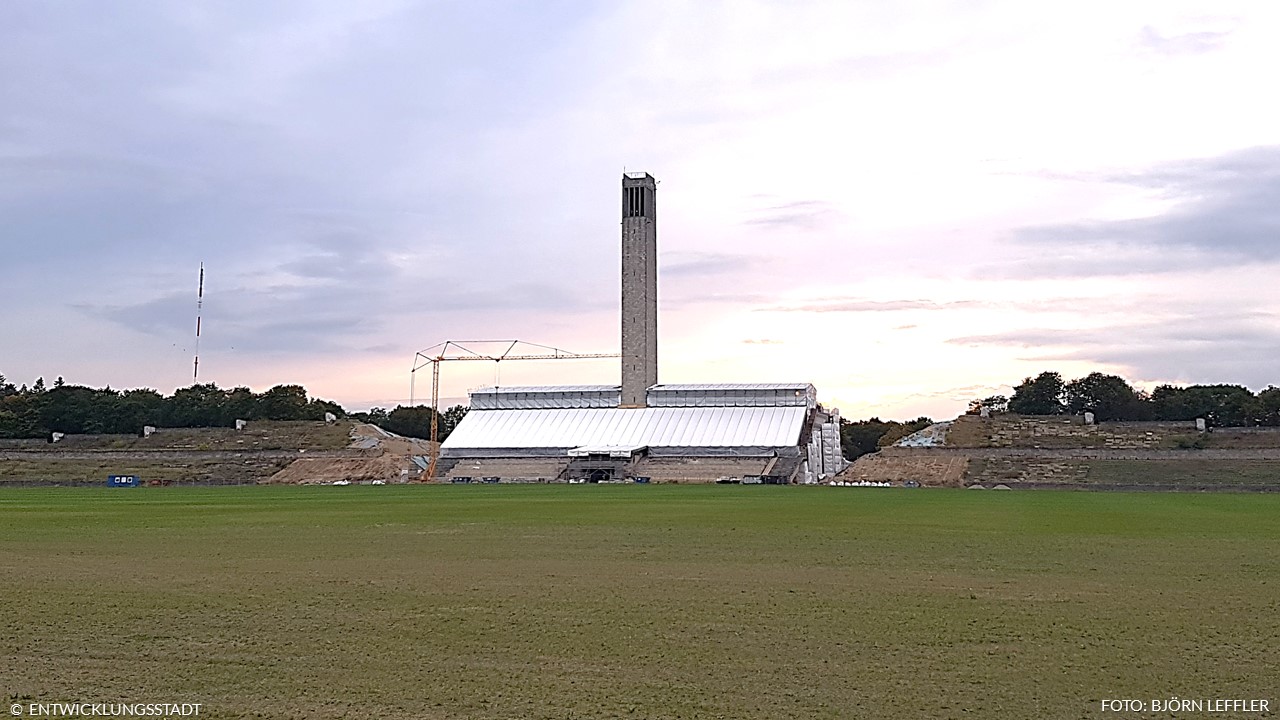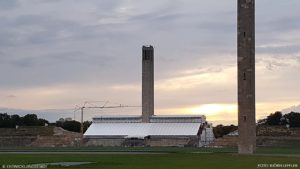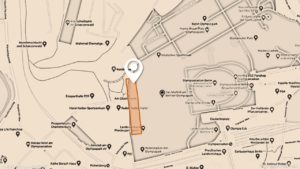ENGLISH VERSION: BELOW
Eine der sichtbarsten Modernisierungsmaßnahmen, die der Senat in den nächsten Jahren im historischen Olympiapark plant, ist die Sanierung der historischen Maifeldtribünen, die den beliebten Glockenturm zu beiden Seiten flankieren.
Die Tribünen waren, wie auch das gesamte Areal samt Olympiastadion, für die Olympischen Spiele 1936 errichtet worden. Während das Olympiastadion zur Fußball-WM 2006 zu einer Hochglanz-Arena umfunktioniert wurde, blieben große Teile des Olympiaparks unverändert.
Umfassende Sanierung der Maifeldtribünen
Dies soll sich nun in den kommenden Jahren ändern. Während noch immer ein schlüssiges Gesamtkonzept für die Nutzung des Areals im Westen der Stadt fehlt und die Zukunft von Hertha BSC als Hauptmieter im Olympiastadion weiterhin ungeklärt ist, investiert der Berliner Senat nun jährlich mehrere Millionen Euro für die Instandsetzung des Geländes.
Die Sanierung der Maifeldtribünen war lange geplant und mehrfach verschoben worden, ist nun aber im letzten Jahr doch begonnen worden. Die Kosten für das Projekt belaufen sich auf rund 21 Millionen Euro.
20 Millionen Euro kostet die Modernisierung
Für die Sanierung der Tribünen sind zwölf Millionen veranschlagt, anschließend werden knapp 9 Millionen Euro für die Einrichtung eines Sportmuseum in den Hohlkammern unterhalb der Tribünen und in den Vorräumen der Langemarckhalle fällig.
Teile der Tribünen samt Glockenturm waren bereits zur WM 2006 saniert worden. Planungen für ein Museum gab es damals allerdings noch nicht, weshalb das Projekt in den Augen einiger Kritiker als zu teuer erscheint. Zudem soll das Museum in einen fensterlosen Tribünenraum hinein gebaut werden, was wegen der aufwendigen Abdichtung gegen Feuchtigkeit sehr kostspielig ist.
Im Tribünenraum unter dem Glockenturm wird ein Museum eingerichtet
Im Zuge der Arbeiten werden und wurden Bäume auf den Böschungen hinter den Tribünen abgeholzt, die Erdwälle abgebaggert und Teile der Treppen, Stützmauern und Stufen entfernt. Große Teile der Tribünen werden quasi neu gebaut, orientiert am historischen Vorbild.
Ursprügnlich war der Einzug für das Sportmuseum in diesem Jahr geplant, was allerdings mittlerweile mehr als fraglich ist, da sich die Bauarbeiten insgesamt verzögert hatten. Bislang sind die Sammlungen, die zukünftig im Museum gezeigt werden sollen, im „Haus des Sports“ auf der Ostseite des Olympiaparks untergebracht.
Am Glockenturm soll das Sportmuseum zukünftig ein touristischer Anlaufpunkt werden, auch die Langemarckhalle und „die Informations- und Serviceangebote des Besucherzentrums am Glockenturm“ sollen in das Gesamtkonzept integriert und ausgebaut werden.
Weitere Artikel zum Olympiastadion und zum Olympiapark gibt es hier.
One of the most visible modernization measures planned by the Senate in the historic Olympic Park over the next few years is the renovation of the historic Maifeld grandstands, which flank the popular bell tower on both sides.
The grandstands, like the entire area including the Olympic Stadium, were built for the 1936 Olympic Games. While the Olympic Stadium was converted into a high-gloss arena for the 2006 World Cup, large parts of the Olympic Park remained unchanged.
COMPREHENSIVE RENOVATION OF THE MAIFELDTRIBUNES
This is now set to change in the coming years. While a coherent overall concept for the use of the area in the west of the city is still lacking and the future of Hertha BSC as the main tenant in the Olympic Stadium remains unresolved, the Berlin Senate is now investing several million euros a year to renovate the site.
The renovation of the „Maifeldtribünen“ had been planned for a long time and postponed several times, but has now been started last year after all. The cost of the project is around 21 million euros.
MODERNIZATION COSTS 20 MILLION EUROS
Twelve million euros have been budgeted for the refurbishment of the grandstands, followed by just under 9 million euros for the installation of a sports museum in the hollow chambers below the grandstands and in the vestibules of the Langemarckhalle.
Parts of the stands including the bell tower had already been renovated for the 2006 World Cup. However, there were no plans for a museum at that time, which is why the project appears to be too expensive in the eyes of some critics. In addition, the museum is to be built in a windowless grandstand area, which is very costly because of the complex sealing against moisture.
MUSEUM TO BE BUILT IN THE GRANDSTAND ROOM UNDER THE BELL TOWER
In the course of the work, trees on the embankments behind the grandstands will be and have been cut down, the earthen embankments dredged and parts of the stairs, retaining walls and steps removed. Large parts of the grandstands are being rebuilt, so to speak, based on the historical model.
The original plan was for the sports museum to move in this year, but this is now more than doubtful, as the construction work as a whole has been delayed. So far, the collections to be shown in the museum in the future have been housed in the „House of Sports“ on the east side of the Olympic Park.
At the Bell Tower, the Sports Museum is to become a tourist focal point in the future, and the Langemarckhalle and „the information and service offerings of the Visitor Center at the Bell Tower“ are also to be integrated and expanded into the overall concept.




